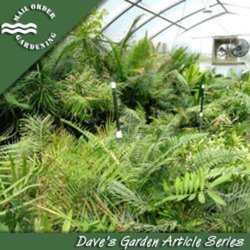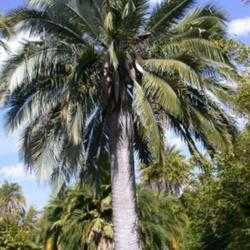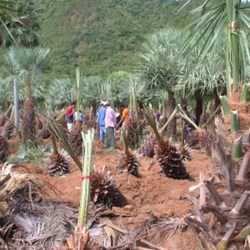Though I keep telling myself I am getting far too old to do this anymore, for some reason I always have a seedbox with little palm seedlings every year. Old age should not keep someone from growing palm seeds, but it does sometimes get discouraging knowing how long it takes to get from a seed to a mature palm. And at an old age, that can be something one may not live long enough to see happen anymore. At least that seems to be the case here in Southern California where palms take 2 to 10 times as long to grow up as they do in warmer, more tropical climates such as in Florida or Hawaii. So if you can grow a palm from a seedling into something large enough to be worth showing off here in California, you can do it anywhere. Growing palms from seeds in subtropical and tropical environments is really a no-brainer in most cases and this article is really not for you folks. But growing palms in a climate where it can stay below 60F for months and months, is damp and cold at the same time, then hot and dry the rest of the time is a real challenge.


this is usually how I get my seedlings now (from mailorder places already grown to the point of being more sturdy... saves time and effort... but not quite as rewarding)
The first thing you need for growing palms from seeds is a place to grow them. If you don't live in a tropical climate, you usually have to create an environment suitable for germination and seedling survival. By far the best option, if you have the room and can afford it, is to have a greenhouse. Though this article is not about building greenhouses, I have to say I have built one in the past and if I can do it, just about anyone can. Where I live now I have no room for one, though, and I have learned that just building a greenhouse is not the same as maintaining one... so it is best to have it done right from the start and perhaps have one built for you if you are not the construction type (which I am most certainly not). But if you do want to build a greenhouse for growing palms, think about what your ultimate goals are. If they are just to grow seedlings, then simple and roomy is best. But if you have loftier plans of growing topical stuff that will never survive outdoors where you live, the taller the greenhouse the better. It does not take long for a palm to outgrow a greenhouse.


inside larger greenhouses- ideal for palms (photos by tigerlily123 and pastime)
 greenhouse in a cooler climate is best way to grow palms there (photo stressbaby)
greenhouse in a cooler climate is best way to grow palms there (photo stressbaby)
But if you do not have the resources or room for an entire greenhouse, that does not mean you cannot successfully grow palms from seeds. You can germinate palm seeds nearly as easily in a small coldframe or even a seedbox. One of the most well known palm growers in here in California grows most of her palms from seeds that just sit in baggies on her kitchen counter. And then the seedlings just need a small, protected area like a small cold frame... or a counter top... to grow on up to a size where one can experiment with taking it outdoors. Descriptions on how to build a coldframe can be found elsewhere, but I will go briefly over a few ways I have constructed a seed box below. One thing to remember with a coldframe is protect it from heat as well as cold. What might be an excellent location in dead of winter could be a killer in summer. Palm seeds and seedlings like it hot, but I have cooked many and know there are limits to their tolerance. Coldframes need ventilation and some sun protection. And coldframes do not need to be walk in... they can be as small as an enclosed hanging shelf unit. All you need are some surfaces to put the seed boxes on and some environmental control. A 3-foot by 2-foot by 1-foot cold frame can hold multiple seedsboxes and hundreds of seeds.


two examples of smaller spaces where on could at least germinate palm seedlings and grow them for a few years (photos by greenhouse)
 coldframe example where one could realistically raise palm seedlings (photo by Sallyg)
coldframe example where one could realistically raise palm seedlings (photo by Sallyg)
Seedboxes are really for germinating seeds only, not for growing the seedlings. With few exceptions, palm seeds like a lot of heat and moisture (this is probably true for most plant seeds, too; but I have little experience with other species.) So you must create a warm, humid environment, preferably that is not easily influenced by the ambient climate you live in. I have excellent results using a variety of seedbox situations... which either means I am a germination genius... or more likely that palm seeds are relatively easy to germinate (this is not always the case with some species however).


this is my dinky seed box with an open top so seedlings can grow in it for a while. The slatted roof on the right is to keep out cats and squirrels
A mostly sealed environment works best (in other words, a lid) though if one is germinating palms that do well in temperate climates one can get away with an open-topped box. This eliminates the need to find someplace else for the seedlings soon after, but it will take longer for germination in most cases. I find a tall box works well for several reasons- better air circulation (less fungus), room for palm seedlings to grow up a bit, and room for hanging a bulb in one plans to heat the box in that way. One of my best seed boxes was one I made out of 2-inch foam insulation panels I cut into a walls and taped together with duct tape (which eventually falls apart, so a better way to hold it together would be nice). It was 3 feet deep and contained a variety of plastic boxes of varying soil depth to germinate different species in. The plastic boxes had numerous holes drilled in the bottom for drainage (with one larger, screened hole in one corner of the insulation box for water to get out- the screen was to keep bugs and mice from getting in).
Soil can be just about anything you want to use that is well draining but holds some water. Potting soils work okay, but there are soils sold specifically for germination if you want. I just use cactus or tropical plant potting soils and add pumice for improved drainage and water retention. Do NOT resuse soil as you will be battling soil funguses as it is. Some recommend sterilizing the soils first by baking them, and them soaking the soils in a liquid antifungal. Sounds good to me but a LOT of work and I have not done that. This precaution will certainly decrease damping off, a real problem with touchy species. Also, some recommend to put a cheesecloth layer or some fine mesh over the top of the box to keep out fungus gnats and mealybugs (another good idea I don't usually follow).

 this soil is about 60% perlite... rest is whatever
this soil is about 60% perlite... rest is whatever
One thing the soil needs is to be constantly moist but not soggy. Letting the soil dry a bit is OK until the seedlings have germinated, but drying out can kill delicate new germinated seedlings very quickly. Growing palm seeds is not something one can do one day, and leave town for a month and expect to have anything living when one gets back. If one has access to a hygrometer which measures humidity, that would be great, and one can work to try to maintain levels between 60% and 75%.
Many professional palm growers germinate their seeds in soiless mediums and these seem to work well, too. Soiless mediums dry out rapidly so these mediums need to be kept in well-sealed plastic bags (zippered sandwich bags work well) or plastic containers. One useful substance used in the baggie method is sphagnum moss, which is first saturated with water, then squeezed out to an even dampness. The seeds are put in with the dampened moss and sealed in baggies and kept warm. The moss must be checked frequently to be sure it's not drying out. Perlite is often used in plastic containers and is also saturated and then drained well. Seeds are placed on top or gently pushed into the top surface and the lid of the container snapped on securely. Again, these containers need to be checked frequently to check for constant moisture. Heat for these can be radiant or surface but should be constant and NOT excessive (see below).
Some species of palm can be germinated at room temperature (usually these are palms from 'room temperature' climates such as Howeas, Chamaedoreas, Chamaerops, Jubaeas and Parajubaeas). Some of these will still germinate better with extra heat, however.


Date palm seedlings grown in a large community bucket (photo mustangman826); Jubaea seedlings in right photo from seed that were discarded after 1.5 years thinking they were no good by that time... and germinated fine at ambient temperatures.
 if you want to grow Queen palms, sometimes all you need to do is go under the tree and collect germinated seeds or even the seedlings
if you want to grow Queen palms, sometimes all you need to do is go under the tree and collect germinated seeds or even the seedlings
For germinating most palm seeds, however, heat is essential. This heat can be from below the seedbox, within the seedboxes or above/around the boxes. I have tried all three and all work well. The only problem with the within-the-soil heating wires is sometimes the palm roots will grow around them and removing a seedling will uproot the entire seed box. For that reason I prefer below-box heat for single shallow boxes, and above/ambient heat for larger enclosures in which multiple boxes are housed. Ideally one should use a heat source that is reliably constant (25C-35Cor 75F-95F is ideal). Some seeds like it a bit hotter, and some like it cooler, but the bulk of palm species germinate well in this range. If you are using a light bulb or two to heat an insulated box or cold frame, a thermostat is a good idea to insure there is no overheating. However, when I made my own box I just kept the whole thing in the shade and it pretty much kept a decent range for germination as long as it wasn't below freezing outside (moving box inside helps then).



these Trithrinax seeds may not have needed heat to germinate in my climate, but heat sure sped up the process... seedlings then moved outdoors in a community pot and middle and right photos show them growing


Seed boxes for germination only- heated by the sun and containing a moist vermiculite soiless medium. Seedlings on the right put in little individual pots once germinated in the box
Under-heat sources are commercially available, but some are pretty pricey. I have used heating pads meant for human use, but this is certainly not recommended as these are fire hazards around water sources. Some heating mats produce excess heat (but are cheaper) so boxes can be raised above these sources a few inches. If you are putting your seed box directly on the heating elements, be sure there is plenty of soil between them and the seedlings or the excess heat at the bottom of the soil will kill the seedlings. But by far it is best to obtain heating mats specifically made for plants and germination. It might be a bit of a cost, but these should last the longest of all the available under-box heating elements. There are many of these available on line. Again, I recommend get one with a thermostat.


on left is a 'real' seedling heat mat complete with thermostat (has a probe that sits in the soil); right is a pig heater I got that is very sturdy, but not adjustable, so I had to lift the box off the surface to keep from damaging the sensitive palm roots
Other things you might need are antifungal spray and insecticide powder (to put on the seeds before putting a bit of growing medium over them).


Though growing palms up from seeds can seem like a gazillion year process, these photos show two different palm gardens in California where most of the palms in them were from seed... just takes patience and a few decades of care
Resources
Palms.org
Articles on cold frames:
http://davesgarden.com/guides/articles/view/2356/
http://davesgarden.com/guides/articles/view/2248/
article on easy greenhouse construction
http://davesgarden.com/guides/articles/view/349/
article on germinating seeds with a heat mat
















